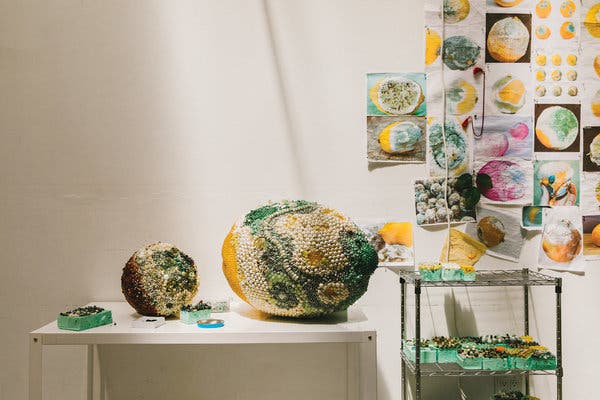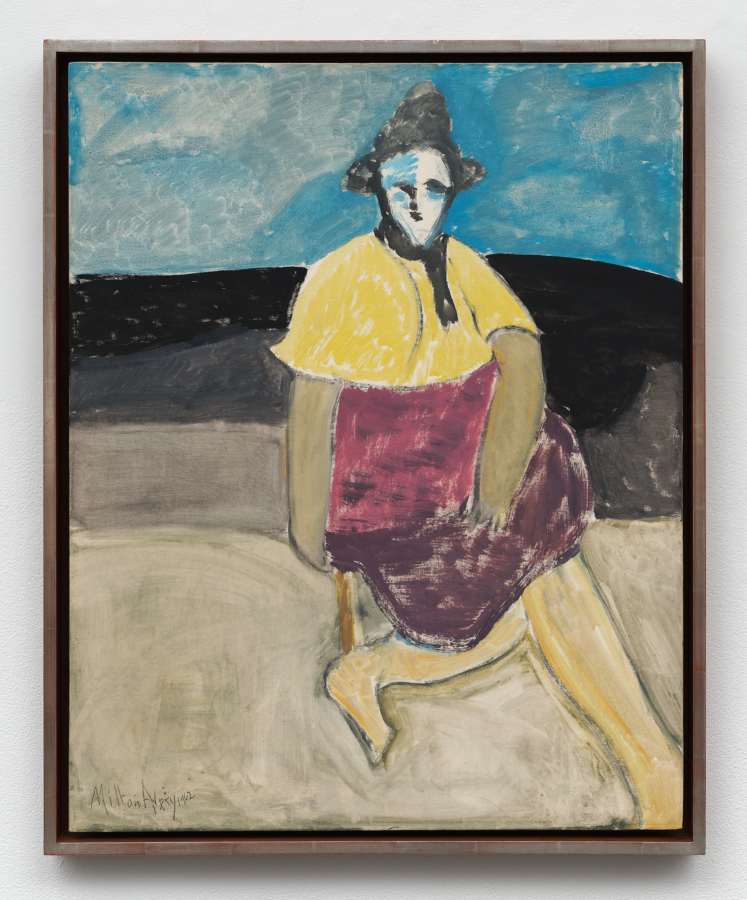September 13, 2019
Download as PDF
View on T: The New York Times Magazine

(Photo: Emiliano Granado)
A swarm of fruit flies has gathered in Kathleen Ryan’s Manhattan studio, which seems appropriate given the mound of oversize, decaying lemons and oranges. The 11-by-16-foot room is a sun-washed garret, taller than it is wide, on the fifth floor of a dilapidated 19th-century commercial building on lower Broadway that the artist has rented since January. In May, she and her boyfriend, the artist Gavin Kenyon (who makes totemic sculptures of concrete and cast iron), also signed a lease on a 3,000-square-foot warehouse in Jersey City, in which she will continue to create her sculptures: monumental, subversive works built from her vast collection of salvaged industrial machinery and thrifted everyday objects — such as fuchsia bowling balls, 35 of which she strung together to create a colossal necklace titled Pearls (2017). But it’s in this Manhattan studio, which has the orderly feel of a small-scale couture atelier, where she’s producing her most intricate work.
Spread across a series of steel worktables are heaps of giant oranges, lemons, peaches (each measuring one to three feet in diameter) and grapes the size of watermelons that Ryan carved from foam and is now spangling with brilliant barnacle-like clusters of semiprecious stones. While each gem — darkly striated emerald-green malachite, milky iridescent opal, smoky quartz — is itself hard and lustrous, together they simulate colonies of fuzzy mold, particularly the common fungus known as green rot (Penicillium digitatum). “The sculptures are beautiful and pleasurable, but there’s an ugliness and unease that comes with them,” Ryan says. Indeed, in their opulence and overripeness, the pieces recall the partially consumed fruit of 17th-century Dutch vanitas paintings by artists such as Jan Davidsz de Heem and Willem Claesz Heda, and likewise comment on worldly excess. It’s over a bowl of real grapes, though, that the flies are crowding: For weeks, Ryan has been observing the fruits’ slowly shriveling skins, now furrowed with mineral-green pastures of mold, in an effort to perfect her simulacra in amethyst, rose quartz and amazonite.
Yan, 35, has always preferred the scavenged and handcrafted to the glossily manufactured. For three years, she worked at the now-defunct fabricator Carlson & Company in Los Angeles’s San Fernando Valley, which produced pieces for major contemporary artists including Charles Ray and Jeff Koons (she worked on his Technicolor polyethylene Cat on a Clothesline [1994-2001] sculptures). “I learned how to take on, and break down, really ambitious projects,” she says. But afterward, while earning her M.F.A., she only wanted to create imperfect, handmade ceramics: “I was really burned out from figuring things out with a spreadsheet.” Her work remains similarly haptic. Ryan spends half of each week at her TriBeCa studio, meticulously piercing the fruits’ foam with steel pins that are each loaded with a bead or a gem. A single lemon takes up to two months to complete and is covered in some 10,000 beads and stones.
Ryan grew up in Santa Monica, Calif., where oranges grow abundantly, and fruit has appeared throughout her practice, symbolizing decadence, one of her longtime preoccupations. For her first solo show, in 2016 at London’s Josh Lilley gallery, she presented the sculpture Bacchante (Tall White) (2016), a cascade of concrete grapes the size of balloons balanced on a vertiginous marble column that subtly undermined the mythic gravity of the piece. It was only after moving to New York two years ago that her produce began to sour.
In December, Ryan will present several of the pieces as part of a giant fruit bowl sculpture at Art Basel Miami Beach; ultimately, she hopes more of her works will be displayed in collectors’ homes, secretly telegraphing a dissident message. “They’re not just opulent, there’s an inherent sense of decline built into them,” she says, “which is also something that’s happening in the world: The economy is inflating, but so is wealth inequality, all at the expense of the environment.” Tellingly, while she uses manufactured glass beads to create patches of ripe skin, the more expensive, naturally occurring gemstones are reserved for the rot. “Though the mold is the decay,” she says, “it’s the most alive part.”



